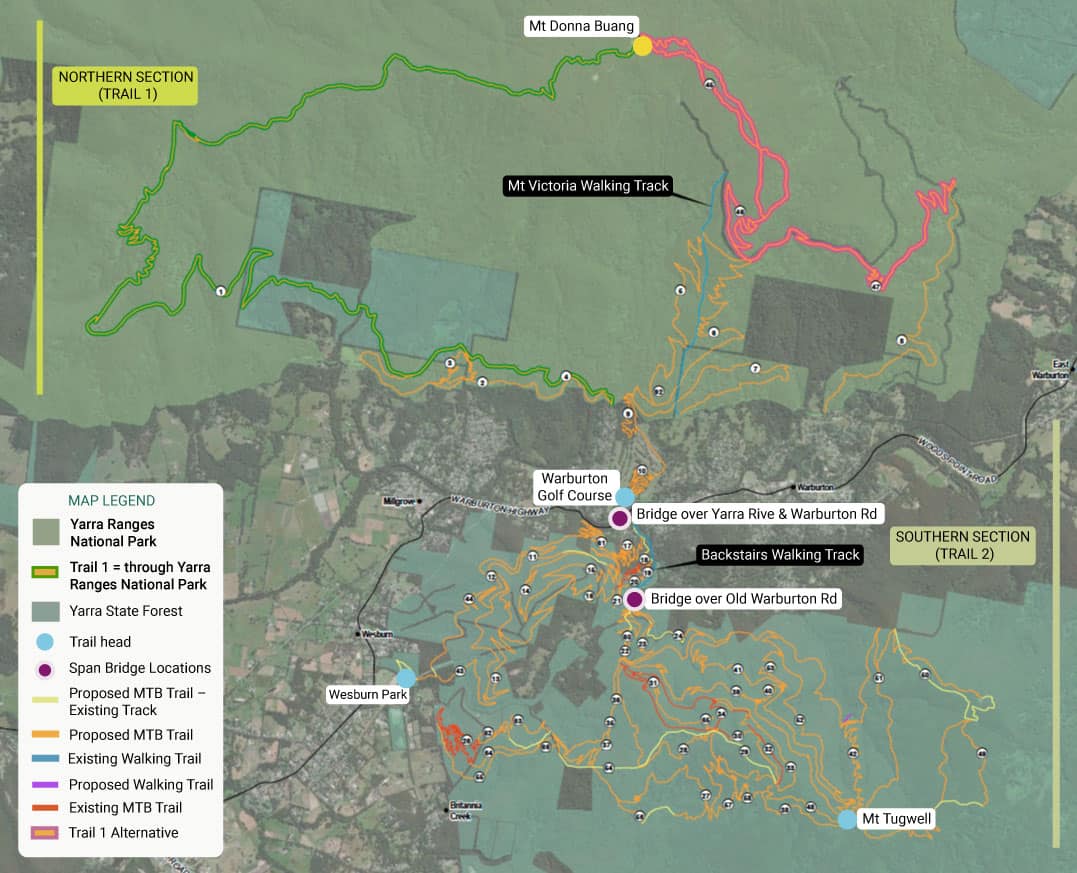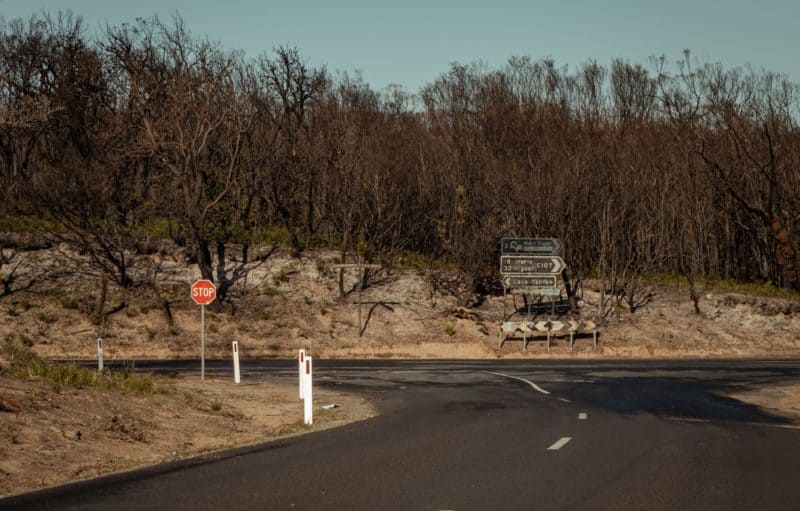Page updated: 25/01/2023
The Yarra Ranges Council wants to build 44 trails spanning 177 kilometres as part of The Warburton Mountain Bike Destination. A large part of this project is planned within the Yarra Ranges National Park.
The aim is to ‘create spectacular riding experiences”. But what about the significant cost to nature, wildlife and water?
The Mount Donna Buang Wingless Stonefly, Leadbeater’s Possum and Cool Temperate Rainforest, along with rare and threatened vegetation, large old trees and hollow-bearing trees are at risk.
The “Warburton Mountain Bike Destination” is heading down the wrong path. The bike tracks proposed for construction in the Yarra Ranges National Park should be abandoned.
Key issues with the proposal
The northern trail network located primarily in the Yarra Ranges National Park, making up just over third of the trails, should be abandoned. The southern trail network, just under two-thirds of the trails, occurs mostly in state forest and could proceed with some modification.
The key issues are with proposed tracks in the Yarra Ranges National Park.
National Parks are supposed to give nature the strongest of protections. Yet this project is being pushed forward by a local council who lack the appropriate authority, and seem oblivious to the impact this project will have on nature.
Parts of the project will cause undue harm to very important ecological values. These include:
Habitat removal
New tracks will see large-scale clearing in one of Victoria’s premier national parks:
- Removal of 35-37 ha of native vegetation (about 17 MCGs) across the track network would be cleared.
- Between 9.15-9.51 ha of native vegetation to be cleared is within the Yarra Ranges National Park.
- Removal of 1.5 ha of Cool Temperate Rainforest, an endangered vegetation community heavily impacted by killer pathogen Myrtle Wilt.
- Tracks will encroach on 3-6.4 km of protected Cool Temperate Rainforest within the national park, increasing the risk of death from Myrtle Wilt pathogen.
- Tracks will be in predominantly high quality wet and damp forests and impact on the regionally vulnerable Heathy Valley Forest.
Impact on threatened plants, animals and communities
The forests of the Upper Yarra are home to an array of endemic, endangered and critically endangered plants and wildlife. If it goes ahead, this project will:
- Remove and damage Cool Temperate Rainforest within a national park and most likely introduce dangerous pathogens and diseases that will damage and kill rainforest trees.
- Negatively impact on the Critically Endangered Leadbeater’s Possum and critical habitat of the possum in the Yarra Ranges National Park, translocation recipient sites and habitat continuity.
- Dissect the sensitive, highly restricted Mount Donna Buang Wingless Stonefly, which only lives within a 2-5km range on the summit of Mt Donna Buang.
- Result in disturbance to soil and hydrology posing a high and unacceptable risk to critical habitat and clean water resources.
- Create issues with erosion in high rainfall area, causing sediment runoff from track creation and operation on local streams and rivers.
- Flow-on impact to water-dependent wildlife such as and Curve-tailed Burrowing Crayfish, Tubercle Burrowing Crayfish, and Mount Donna Buang Wingless Stonefly.
- Threaten a plethora of wildlife within the track corridor or nearby; 26 state-listed species and 12 federally-listed species.
- Intersect 42 waterways, with 166 crossings, six of which are located in areas of high-risk landslide susceptibility and none located in land subject to an inundation overlay.
Attack on the integrity of national parks
National parks are the jewel in Victoria’s crown, they should be cared for with all in mind, yet:
- There has been no assessment of the project against the objectives of the National Parks Act 1975, which is supposed to protect whole ecosystems in perpetuity.
- The proposal is inconsistent with the purpose of the park’s own National Park Management Plan.
- There has been no approval for the track to be in the national park, even though both local, state and federal government have thrown over $11 million at the project.
- The proponents failed to undertake due diligence and gain approval fo the proposal, a waste of taxpayer money and a poor process.
- The project benefits parts of the local economy but has no return to the park itself and will only damage the integrity fabric of the park and increase management costs.
- This proposal reinforces conflicting protections – in Victoria, cool temperate rainforest is protected from logging, but not from the construction of bike tracks.
- High speed bike riding tracks in a national park conflict with predominant users of the park being bushwalkers and short walk users.
Impacts on heritage values, pests and water catchments
Parks protect a wide range of values for everyone, forever. We must manage them to protect these values. The project will:
- Damage sites listed under the Heritage Inventory and Heritage Overlays within the national park.
- Create biosecurity issues associated with the spread of Phytophthora and Myrtle Wilt, and spread pest weed species into high-quality areas.
- Incur into water catchments that have been closed to protect water quality since the 1800s.
Neglected social & economic impacts
Adverse impacts on the community and parks have been downplayed.
- In proposing this large development in an area of extreme bushfire risk the Yarra Ranges Council is ignoring their own planning scheme and state legislation.
- Marketing copy like “world-class mountain biking experience” and “facilitate tourism growth” is thrown about to highlight the project’s benefits. Little mention is made of the socio-economic assessment that showed increased traffic impacts, a decrease in liveability for local residents and a reduction in affordable housing.
- The economic modelling underpinning the project did assess alternatives, including a “no trails in the national park” option. While modelling shows a greater return for the full proposal, the proposal without track in the national parks avoiding the key ecological impacts did show significant benefits to the regional economy..
- A trail without the northern national park section (Track 1) modelled an increase in regional spending by $19.1 million in its first year, to $28.4 million in its tenth year. This scenario would generate 90.5 full-time equivalent jobs in the first year, increasing to 131.7 full-time jobs in its tenth year. This demonstrates the preferred, alternative option of both protecting the environment and creating significant economic benefits.
- A summary in one of the Environment Effects Statement’s reports concludes: “This analysis determined that inclusion of Trail 1 in the trail network would provide significantly greater economic benefits but would also have potential for more significant biodiversity impact”, (pp 42, Alternatives Assessment Report).
Useful resources
- Warburton Mountain Bike Destination – Environment Effects Statement (EES)
- Downloadable submission guide (MS Word)
- Our preliminary submission to the Warburton Mountain Bike Destination Environment Effects Statement (Dec 2020)
- Our final submission to the Warburton Mountain Bike Destination Environmental Effects Statement (Jan 2022)
The proponent of the project is the Yarra Ranges Council with funding from the Federal Government, State Government, Yarra Ranges Council, and Bendigo Bank through the Upper Yarra Community Enterprise. So far $11.3 million of funding has been secured.
Why did the project need an Environment Effects Statement (EES)?
The EES covers 170km of tracks due to the potential impact on threatened and endangered plants, animals and ecosystems.
The proposed bike trails are mainly on public land and forest (traversing Yarra Ranges National Park, parts of Mt Donna Buang’s summit and Yarra State Forest).
The network is made up of two networks of tracks:
- The northern trail network (located on the north side of the valley) consists of around 36 per cent of the trails, most occurring in the national park.
- The southern trail network (located on the south side of the valley) consists of around 64 per cent of the trails, mostly in state forest.

